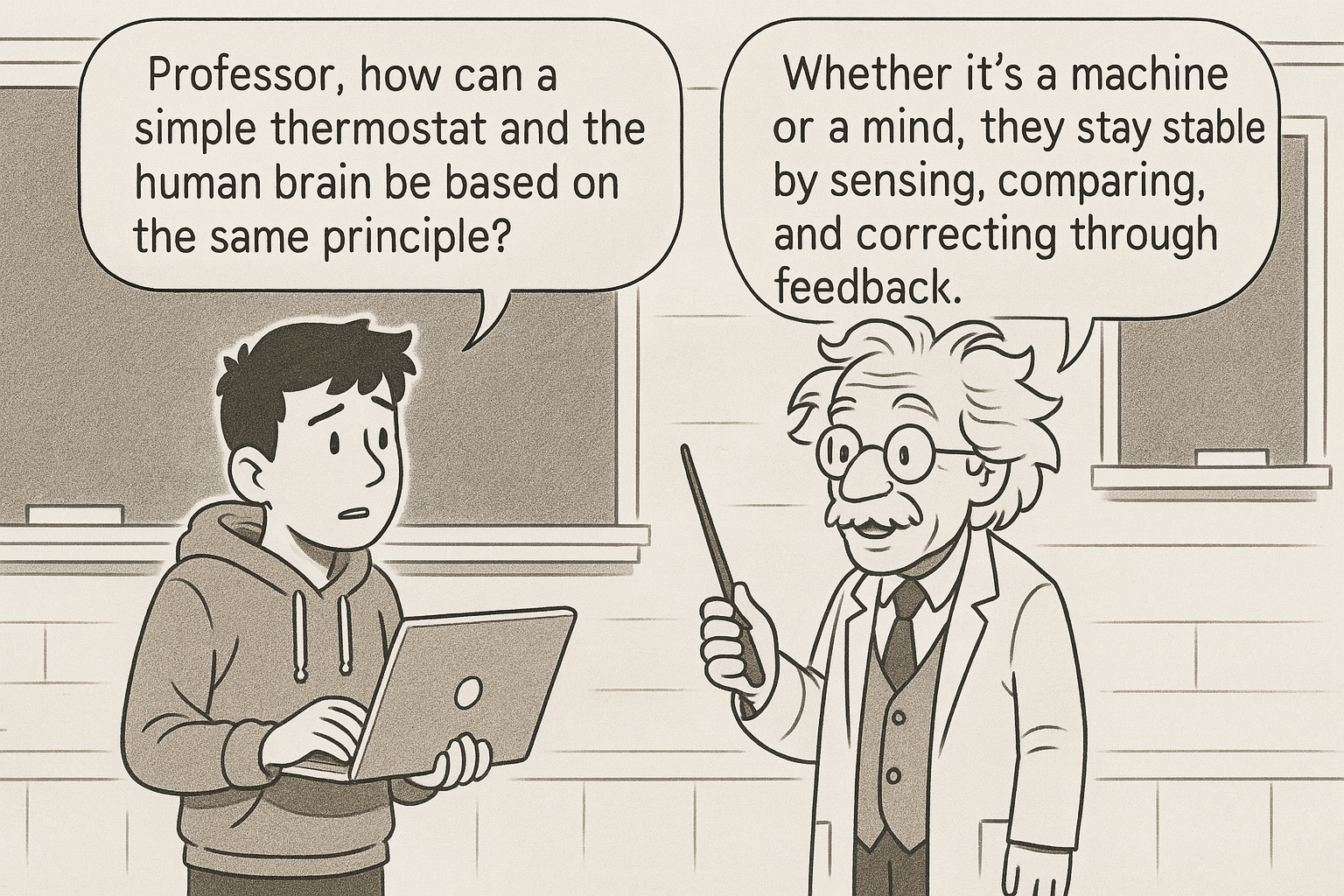Introduction
In 1948, MIT mathematician Norbert Wiener published "Cybernetics Or Control and Communication in the Animal and the Machine" establishing the first unified theory connecting biological and artificial intelligence through information processing and feedback control. This work introduced the term "cybernetics" to describe self-regulating mechanisms and laid the theoretical foundation for servomechanisms, automatic navigation, artificial intelligence, neuroscience, and reliable communications. The book became an unexpected bestseller, reaching far beyond Wiener's intended technical audience to influence diverse fields from robotics to social sciences.
"Communication and control in systems create the bridge between mechanical precision and biological wisdom."
Core Ideas
Wiener's central insight was revolutionary in its simplicity and scope. He recognised that the fundamental challenge facing both living organisms and machines was the same: how to maintain organisation and purpose in a world constantly threatened by disorder and noise. At the core of his theory was the message (information), sent and responded to through feedback loops. The functionality of any system—whether machine, organism, or society—depends entirely on the quality of these messages.
The book's foundation rested on a profound connection between information theory and statistical mechanics. Wiener demonstrated that information and entropy are inverse concepts: "just as the amount of information in a system is a measure of its degree of organisation, so the entropy of a system is a measure of its degree of disorganisation; and the one is simply the negative of the other." This relationship provided a mathematical framework for understanding how systems maintain stability and purpose.
Wiener's approach was deeply interdisciplinary, drawing from his decade-long collaboration with medical scientists, physicists, and engineers at Harvard Medical School. He connected the work of physicist Willard Gibbs on statistical mechanics with mathematician Henri Lebesgue's integral theory, showing how mathematical concepts from seemingly unrelated fields could illuminate the fundamental principles governing both biological and mechanical systems.
The concept of feedback emerged as the central mechanism of cybernetic systems. Wiener examined railway signalling, thermostat operation, and steam engine centrifugal governors to illustrate how negative feedback allows systems to self-correct and maintain stability. He contrasted this with the devastating effects of faulty feedback, using examples of patients with various forms of ataxia to demonstrate how broken control mechanisms lead to system failure.
Breaking Down the Key Concepts
To understand Wiener's breakthrough, consider a simple thermostat in your home. The device continuously monitors temperature (input), compares it to your desired setting (reference), and adjusts the heating or cooling system (output) accordingly. When the room gets too warm, the thermostat reduces heating; when it gets too cold, it increases heating. This feedback loop maintains your desired temperature without constant human intervention.
Wiener showed that this same principle operates in biological systems. Your body maintains constant blood sugar levels through feedback mechanisms involving the pancreas and liver. When glucose levels rise, insulin is released to bring them down; when they fall, different hormones restore balance. This homeostasis—the maintenance of stable internal conditions—became a fundamental concept in cybernetics.
The genius of Wiener's approach was recognising that information corrupted by noise prevents homeostasis and leads to system breakdown. In any communication system, whether between neurons in your brain or components in a computer, the quality of information transmission determines the system's ability to function effectively. Poor information leads to poor decisions and system failure.
Wiener also explored the fascinating thought experiment of Maxwell's demon, relating the concept of entropy to information and examining how a hypothetical being could sort fast and slow molecules to create perpetual motion. This analysis helped establish the deep connection between information processing and thermodynamic principles that would later influence computing theory.

Results and Significance
Wiener's work provided the theoretical foundation for numerous technological developments that we work with daily. The book laid the theoretical foundation for servomechanisms (whether electrical, mechanical or hydraulic), automatic navigation, analog computing, artificial intelligence, neuroscience, and reliable communications.
For tech professionals, cybernetics principles are embedded in every system you build. Modern control systems in manufacturing, the algorithms that optimise traffic signals in Bengaluru, the feedback mechanisms in mobile networks, and the adaptive systems in machine learning all trace their conceptual roots to Wiener's 1948 work.
The book's influence extended far beyond engineering. Wiener is credited as being one of the first to theorise that all intelligent behaviour was the result of feedback mechanisms, that could possibly be simulated by machines and was an important early step towards the development of modern artificial intelligence. This insight directly influenced computer pioneer John von Neumann, information theorist Claude Shannon, and laid groundwork for the digital revolution.
Wiener's prescience was remarkable. He warned against "noise" in information systems, showed disdain for "hucksters" and "gadget worshipers," and viewed mass media as potentially anti-homeostatic forces in society. In a note at the end of the book, Wiener speculated about chess-playing machines, stating they "might very well be as good a player as the vast majority of the human race." This prediction proved accurate when IBM's Deep Blue defeated world champion Garry Kasparov in 1996.
The mathematical frameworks Wiener developed, particularly his work on time series analysis and filtering (later known as the Wiener filter), became foundational to signal processing and digital communications. These concepts directly enable technologies we use daily, from digital audio processing to noise reduction in telecommunications.
Read the full book here - https://direct.mit.edu/books/oa-monograph/4581/Cybernetics-or-Control-and-Communication-in-the